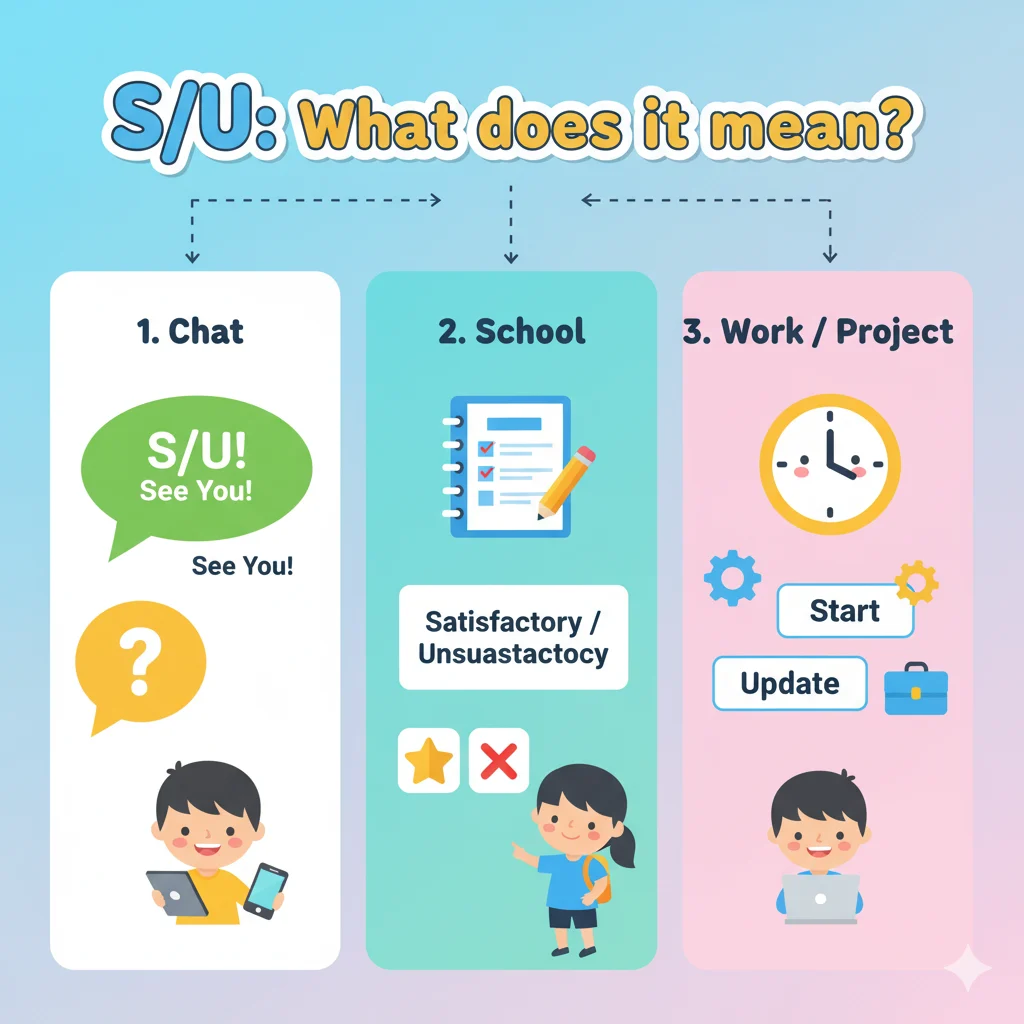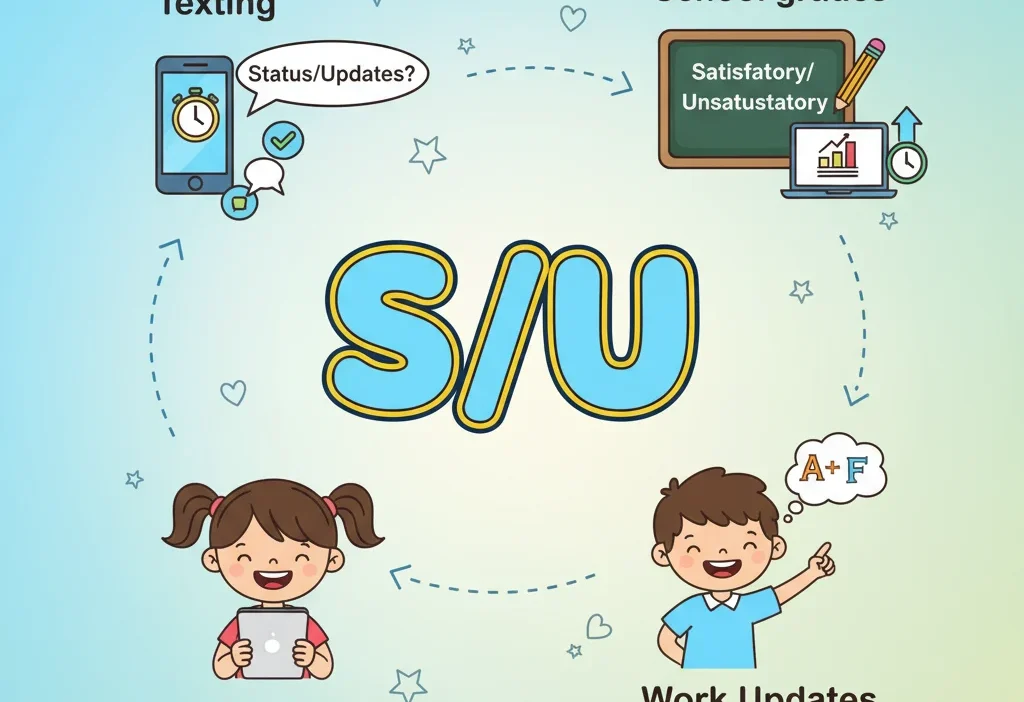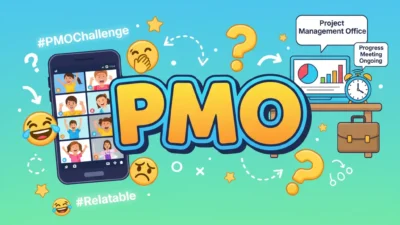“S/U” usually stands for “See You” in text messages, chats, and online conversations.
It’s used to say goodbye casually to friends, classmates, or colleagues.
Sometimes, depending on context, it can also mean Satisfactory/Unsatisfactory in schools or Start/Update in workplaces.
Why People Use S/U
In the digital age, texting abbreviations like S/U make conversations faster and easier. Instead of typing “See you later,” people often shorten it to S/U.
Learning S/U is important because:
- It helps you understand informal chats from friends or online communities.
- It prevents confusion between different meanings (like school grades or messages).
- It lets you use texting abbreviations confidently.
This guide covers:
- The main meaning of S/U in texting
- Other possible meanings (school and work)
- How to use it correctly in sentences
- Comparison with similar abbreviations
- Mini quizzes and practice exercises
- Tips, tricks, and FAQs
By the end, you’ll master S/U in different contexts and never be confused again.
Main Meaning of S/U: “See You”
The most common use of S/U is in texting and chatting, where it means “See You.”
Simple Examples:

- “I have to go now, S/U!”
- “Thanks for helping! S/U tomorrow.”
- “Meeting ended, S/U online later.”
Think of it as a friendly way to say goodbye quickly.
Tips for Using S/U in Chatting:
- Combine with other abbreviations: “BRB, S/U later.”
- Use it with friends, classmates, or informal chats.
- Avoid in formal or professional messages.
Other Meanings of S/U
Sometimes, S/U has different meanings depending on context:
1. School or College — Satisfactory / Unsatisfactory
Many schools and colleges use S/U grading to show if a student’s performance meets minimum requirements.
| Abbreviation | Meaning | Example |
|---|---|---|
| S/U | Satisfactory / Unsatisfactory | “Your grade is S/U for this semester.” |
| S | Satisfactory | “You passed this assignment with S.” |
| U | Unsatisfactory | “Your project is graded U.” |
Tip: When seeing S/U in school or university documents, it usually refers to grades or evaluations.

2. Workplace / Business — Start / Update
In professional or business communication, S/U can mean Start/Update, often used in project management or emails.
Examples:
- “Please S/U on the project progress.”
- “Can you S/U with your tasks by Friday?”
Tip: Context is key — if it’s a workplace or business message, S/U likely means Start/Update.
3. Other Uses (Rare)
Some online forums or games may use S/U for specific terms, depending on the platform.
Always check the context to be sure.
How to Use S/U Correctly
1. Texting / Chatting
- With friends:
“Lunch done, S/U later!” - On social media:
“Great game today! S/U tomorrow.”
2. School Context
- “Your assignment is graded S/U.”
- “Check your results for S/U status.”
3. Workplace / Business Context
- “Please S/U on the progress report.”
- “Can you S/U with updates by noon?”
Tip: Always consider the context to pick the correct meaning.
Common Mistakes People Make with S/U
Description:
This section can explain errors like confusing S/U with CU or TTYL, using it in formal emails, or misinterpreting the meaning in school/work contexts. You can include examples of wrong vs correct usage.
Example content snippet:
- ❌ “Please S/U on your homework” (wrong in a school context if talking to teacher)
- ✅ “I’ll finish homework, S/U later” (correct informal chat usage)
Fun Ways to Remember S/U
Description:
This section can give memory tricks, visual aids, or rhymes to help readers remember the different meanings of S/U (chat, school, work).
Example content snippet:
- 💬 Chat → S/U = See You → ❓ question mark icon
- 🏫 School → S/U = Satisfactory / Unsatisfactory → 📝 notebook icon
- 💼 Work → S/U = Start / Update → ⏱️ clock or arrow icon
S/U vs Other Abbreviations
It’s easy to confuse S/U with other chat abbreviations. Here’s a simple comparison:

| Abbreviation | Meaning | Example |
|---|---|---|
| S/U | See You | “Going home, S/U!” |
| CU | See You | “CU tomorrow at school.” |
| TTYL | Talk To You Later | “Done chatting, TTYL!” |
| BRB | Be Right Back | “Eating dinner, BRB.” |
| S/U (school) | Satisfactory / Unsatisfactory | “Your grade is S/U.” |
| S/U (work) | Start / Update | “Please S/U on your tasks.” |
Tip: If the meaning isn’t obvious, look at the context: school, chat, or work.
Examples in Conversations
Text Chat (Informal)
- Alex: “I gotta go now.”
- Sam: “Okay, S/U later!”
Social Media Post
- “Class ended, S/U all tomorrow!”
Work Chat
- “Meeting finished, S/U online later.”
School Report
- “Your semester performance: S/U.”
Project Email
- “Please S/U with updates by 3 PM.”
Comparison Tables for Clarity
S/U Meanings by Context
| Context | Meaning | Example |
|---|---|---|
| Chat / Text | See You | “Going home, S/U!” |
| School | Satisfactory / Unsatisfactory | “Your assignment grade: S/U.” |
| Workplace | Start / Update | “Please S/U on your tasks.” |
S/U vs CU vs TTYL
| Abbreviation | Meaning | Use Case |
|---|---|---|
| S/U | See You | Quick goodbye in chat |
| CU | See You | More common online, casual |
| TTYL | Talk To You Later | Longer break before next conversation |
Tips to Remember S/U
- Think of context: Chat = See You, School = Grade, Work = Update.
- Use only in informal chats for “See You.”
- Combine with other abbreviations: “BRB, S/U later!”
- Check school reports carefully to know if it’s S/U as a grade.
Memory Trick:
- ❓ Chat / texting → S/U = See You
- 🏫 School → S/U = Satisfactory / Unsatisfactory
- 💼 Work → S/U = Start / Update
Mini Quiz for Practice
Choose the correct meaning of S/U:
- “I’ll finish homework, S/U later.” → ?
- “Your grade is S/U for this course.” → ?
- “Lunch done, S/U tomorrow.” → ?
- “Please S/U on your project update.” → ?
Answers:
- See You
- Satisfactory / Unsatisfactory
- See You
- Start / Update
Practice Exercise
Rewrite these sentences with the correct meaning of S/U:
- I’ll meet you later, S/U!
- Your project is graded S/U.
- Can you S/U the report by Friday?
- Going home now, S/U!
Corrected Answers:
- See You → informal chat
- Satisfactory / Unsatisfactory → school
- Start / Update → workplace
- See You → informal chat
FAQs About S/U
Q1: Can I use S/U with teachers or bosses?
A1: Only use the See You meaning in informal emails. For professional emails, write full words.
Q2: Is S/U the same as CU?
A2: Yes, both mean See You, but CU is more widely recognized online.
Q3: Can S/U be used in text messages only?
A3: Mostly yes, because it’s informal and short.
Q4: Are there other meanings for S/U?
A4: Yes, school grading (S/U) and workplace updates (Start/Update).
Q5: How do I know which meaning applies?
A5: Check the context: chatting, school, or work.
Q6: Can S/U be used in emails?
A6: Only in informal emails or messages to friends. Avoid in professional emails.
Q7: How to remember S/U meanings?
A7: Chat = See You, School = Satisfactory / Unsatisfactory, Work = Start / Update.
Conclusion: Use S/U Confidently
S/U is a versatile abbreviation:
- Chat / texting: Say goodbye → S/U = See You
- School / college: Grades → S/U = Satisfactory / Unsatisfactory
- Work / business: Projects → S/U = Start / Update
With all the examples, comparison tables, quizzes, and tips, you now understand S/U fully and can use it confidently in the right context.

Emily Dickinson expressed profound spiritual truths through the quiet beauty of her poetry. Her words explore life, death, nature, and eternity with tender simplicity and deep symbolism. Dickinson’s gentle insight continues to inspire readers to look beyond the visible and feel the divine in silence and solitude.



